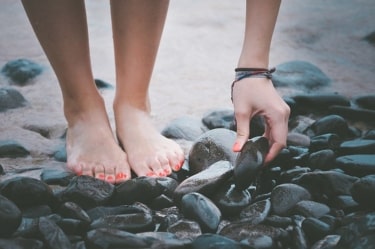This post may contain affiliate links. Please read the disclaimer for more info.
If you are someone who has played a sport or been part of an activity that does high levels of running, this may be a topic you have had to look into in the past.
Whether or not you are an active person however, overpronation has a high chance of effecting you throughout your adult life as Dr. Axe’s website sites that “collapsed arches may now affect the majority of the adult population living in industrialized nations”.
Collapsed arches lead to us developing flat feet and this is the direct cause of overpronation. The large arch muscle in our foot is not being activated or is not strong enough for a variety of reasons if you are experiencing this.
Pronation is a natural movement pattern that the human body goes through to generate force from the ground, through our feet, and into our legs when moving forward. This begins with us landing on the outside of our heel when walking, rolling our forefeet and big toe (and second toe) flat so our toes can grip the ground enabling the arch to be activated, and pushing off through them.
When we overpronate, our feet collapse in too far towards the midline of our body because our toes aren’t strong enough to engage the arch or the arch is too weak on its own to stop the foot from collapsing too far in. This action creates a lot of pain in the foot and ankle and can lead to several other common injuries that I discuss right here on this website.
It’s worth noting that flat feet (and overpronation) lead into many other sources of pain further up the kinetic chain such as in the ankles, calves, knees, and back. So someone who has runner’s knee or any kind of back pain should first look to the bottom of the kinetic chain and start addressing issues found from the feet on upward.
Without further ado, let’s get into a few ways to fix your overpronating feet:
1. Stretch Your Legs
If you are overpronating, there’s an incredibly high chance that your lower leg muscles are already tight and your body is trying to compensate for that by mobilizing the foot inward. The biggest problems areas are almost always the calves and achilles tendon.
You should make sure that you are stretching your calves after every single workout and making a daily habit out of some kind of stretching exercise for your achilles and calf muscles.
2. Change Your Footwear
This was a complete game changer for me as I was wearing shoes for a long time that were everything my feet did not want!
A few things to think about here – first, your toes need room to spread out and flex so you can actually use them to their fullest potential. They are ultimately what help you form and utilize the arches in your feet. So shoes with a bigger toe box are a must.
Second, make sure the shoes you’re wearing do not have an elevated heel (most traditional shoes do).
It’s important to get rid of this because the elevated heel is going to shorten your calf and achilles muscles more and more over time causing them to be very tight. This will keep you from making good progress toward getting away from foot and ankle injuries.
3. Strengthen Your Core Muscles
An interesting point that is surprising to many is that tight and weak core muscles affect the rest of our body more than we often think, even down to our feet.
It turns out that having weak abdominal muscles and gluteus muscles can throw off the alignment of our hips, causing our upper legs to turn inward and inevitably collapse our feet inward when we walk or run. Strengthening these muscles through a host of exercise options can minimize or altogether solve this overpronation problem.
As for tight core muscles, the hip flexors and extensor muscles in the lower back have been cited as the two most common for throwing off this hip alignment. These should be given attention just like the other core muscles should as these may be causing tightness down into the lower legs.


Leave a Reply